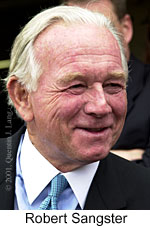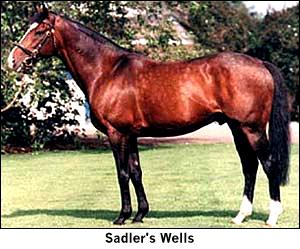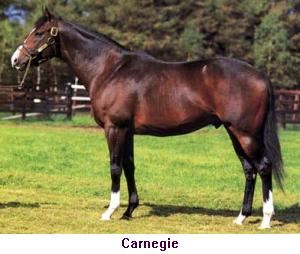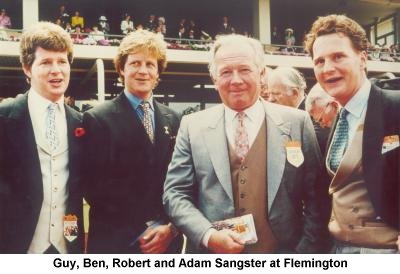 In a sport as well known for its monumental flops as its outstanding
successes, running a racing and breeding business spread across three continents is
no mean feat. In the past 10 years, 8 have been profitable for a vast racing and breeding
operation turning over tens of millions of dollars a year. In a sport as well known for its monumental flops as its outstanding
successes, running a racing and breeding business spread across three continents is
no mean feat. In the past 10 years, 8 have been profitable for a vast racing and breeding
operation turning over tens of millions of dollars a year.Such is the achievement of Robert Sangster's Swettenham Stud, with bloodstock
interests in Europe, North America and Australasia. With his three sons, Guy, Ben and Adam
progressively taking more responsibility for the operation, Sangster has not only
established one of the world's most successful racing corporations, but has also ensured
its continuity.
In Australia alone, he has been enormously successful,
having owned or bred the winners of Derbys, Melbourne and Adelaide Cups, Golden Slippers,
Guineas and a host of other prestigious winners.
Admittedly, starting off as the heir to the Vernons Soccer
Pools fortune gave Sangster the wherewithal to indulge in a growing passion for racing, at
a time when the aristocracy dominated the ranks of British owners. "Prizemoney was
and is still is very low, but the aristocracy didn't mind because they could fund racing
from other sources" said Sangster.
For quite a while, Sangster was content for racing to be a
loss making hobby, propped up by substantial income from the Soccer Pools and other
business interests. He moved into breeding after purchasing the Swettenham Hall property
in the 1960's. Even then Sangster was fascinated by the opportunities he saw in racing and
breeding internationally.
"I first visited Australia in the early 1970's setting
up Soccer Pools and Lotto" Sangster remembered. "I was most impressed by the
media coverage of racing. There were whole sections of the newspapers devoted to racing,
whereas in North America you'd be lucky to find a single article".
Sangster became friendly with Ken Cox of Stockwell Stud and
began to explore the possibility of earning two sets of service fees in a year by
shuttling Northern Hemisphere based stallions to Australia. "I wanted to send
Rheingold, who'd won the Arc, but the other owners thought he was too valuable to send to
Australia and the deal fell through" said Sangster.
He was more successful with shuttling the stallion Deep
Diver, who was bred as Sangster put it "with speed on speed". He recalls a
television interview with Ken Cox who was very critical of Deep Diver's pedigree because
of this emphasis on speed. "I pointed out to Cox that his record breaking stallion
Showdown had speed on both sides of his pedigree".
Even at that stage, Sangster appreciated the value of
"an ability to quicken" and actively sought stallions with that quality. "I
really like a stallion who has shown ability as a miler" he said.
As it happened, neither Rheingold or Deep Diver had a big
impact on the world breeding scene, but these initial forays were good experience later in
the 70's and early 80's when his association with John Magnier and Vincent O'Brien led to
the trio revolutionising the breeding business.
Their concept was breathtakingly simple. Instead of waiting
for a horse to finish its racing career having won a Derby or Arc, before deciding it was
worth syndicating as a stallion, they painstakingly assessed the stallion potential of
horses at the yearling stage and purchased in effect "baby stallions". With
astute selection combined with sound training, they would give their stallion prospects
every chance of success. Those that made it could be syndicated for vast sums - more than
enough to make up for the failures.

Such successes included the stallion Assert, sold for $28
million and the champion sire Sadler's Wells, who was actually bred by Sangster, thus
saving him the problem of buying him as a yearling. "We still send twelve mares each
year to Sadler's Wells" said Sangster, which illustrates another aspect which is key
to Swettenham's profitability - a portfolio of shares in some of the world's top
stallions, combined with broodmares of comparable quality.
Interestingly, although Sangster readily agrees that
"we identified early on the sire potential of the Northern Dancer line", he is
completely at a loss to guess where the next dominant stallions will come from. "I
wouldn't have a clue" he said when asked.
Rising star Carnegie, winner of the Prix de l'Arc de
Triomphe was bred by Sangster by sending his prize mare Detroit (also winner of the Arc)
to Sadler's Wells. "I bought her in the first place after Irish bloodstock agent Pat
Hogan, had been to Alec Head's place in France to inspect four of my yearling fillies. Pat
rang me and said I had to buy the one filly in the paddock I didn't own, so I did"
Sangster recalled.
Sangster still regrets selling Carnegie to Godolphin as a
foal, even though the price was good. "I think he's going to be a top stallion - he's
already doing very well" he commented. Perhaps some consolation can be gained from
the fact that Swettenham own several full sisters to Carnegie. "We have either four
or five sisters to him. Unfortunately Detroit died foaling last year and I can't remember
whether the last foal survived".

This capacity to retain close relations to top performers
means that Sangster's reputation as "a great seller" doesn't often lead to the
loss of irreplaceable bloodlines. For instance, the Australian arm of Swettenham, run by
Sangster's son Adam, has a broodmare band almost entirely composed of Group winners or
Group producers. Many of them carry the blood of Sir Tristram, who Sangster saw early on
was going to be a top broodmare sire and purchased several breeding rights.
Swettenham "owns a significant chunk of champion
stallion Danehill", according to Sangster and of course those same Sir Tristram
bloodlines are being bred back to Danehill, with great racetrack success.
Sangster attributes much of Swettenham's success to its
decision making. "We probably use family resources 50% of the time to make decisions.
My son Guy is very much involved in the business aspects and Ben has developed a top
reputation for his knowledge of horses - even John Magnier values his opinion. Adam's come
ahead in leaps and bounds over the past 5 years and our Australian operation is a credit
to him".

He was quick to point out that Swettenham "has many
people to turn to when it needs external advice" and that "we couldn't operate
without the many enduring associations we have formed over the years".
Another aspect of the Swettenham investment in Australia is
its half share of Collingrove Stud in Victoria, the other half being owned by the Hayes
family, with whom Sangster has had one of those "enduring associations".
Sangster said he was "proud of the fact that Collingrove is debt free and profitable.
We're spending a substantial amount on improvements this year. I'm very pleased with the
progress we've made".
The stallion population of Collingrove is to a significant
degree, a reflection of a lifetime of enduring associations with the world's top breeders.
The ability to procure horses like Danehill Dancer, Favorite Trick, Bianconi and Marju is
helped, as Sangster put it "by the fact that I've known their owners for a long
time".
Sangster also owns all of Collingrove Stud at Sandy Hollow
in New South Wales. Last season the facility was leased to Darley Stud, the Australian arm
of the formidable Godolphin organisation. However it was the Collingrove staff employed by
Sangster who operated the stud and its 4 shuttle stallions, Singspiel, Xaar, King's Best
and Lujain.
Internationally, the emphasis over the past decade seems to
have been selling rather than racing which was very much the go in the 70's and 80's. In
Australia, virtually all of the Swettenham bred horses have been sold as yearlings, with
the familiar green and blue colours seen rarely on the track.
Sangster hinted that this may be about to change however.
"I think we may retain a few fillies next year and have some fun" he said with
obvious relish. Sangster's ability to have fun with his racing is legendary - but its odds
on that some of those fillies will become valuable broodmares one day. |